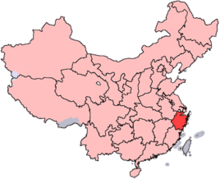| Anji Bai Cha | |
|---|---|
| Type | Green |
| Other names | Anji white tea,安吉白茶 |
| Origin | Anji County, Zhejiang Province, China |
| Quick description | Rare, large-leafed green tea |
 |
Anji bai ( Chinese: 安 吉 白; pinyin: Ānjí bái; pronounced [án.tɕǐ pǎɪ]) or Anji white [1] is a green tea originally produced in Anji County, Zhejiang Province, China. [1] Now, it can also be found in Changxing County, Zhejiang Province, China.
This tea cultivar was discovered in 1982, is not as widely planted as other teas and has a short harvesting period; it is a comparatively rare tea, and as such, is among the most expensive teas in China. [2]
It is called "white" tea although it is a green tea. [3] The long, narrow leaves are yellow in colour and have a recognisable fold along the length of the leaf. [4]
A 2010 study found that the tea is high in polysaccharides which can inhibit the hemolysis of blood cells. [5]
See also
References
- ^ a b "An Ji Bai Cha". Archived from the original on 2016-03-10. Retrieved 2016-02-24.
- ^ "Anji White Tea". Kaleidoscope - Food Culture. Cultural China. Archived from the original on 6 June 2014. Retrieved 4 June 2014.
- ^ "Anji White Tea". Tea Encyclopedia. Archived from the original on 8 September 2014. Retrieved 4 June 2014.
- ^ Mary Lou Heiss; Robert J. Heiss (18 January 2012). The Tea Enthusiast's Handbook: A Guide to the World's Best Teas. Ten Speed Press. p. 44. ISBN 978-1-60774-378-1.
- ^ Victor R. Preedy (2013). Tea in Health and Disease Prevention. Academic Press. p. 233. ISBN 978-0-12-384937-3.
| Anji Bai Cha | |
|---|---|
| Type | Green |
| Other names | Anji white tea,安吉白茶 |
| Origin | Anji County, Zhejiang Province, China |
| Quick description | Rare, large-leafed green tea |
 |
Anji bai ( Chinese: 安 吉 白; pinyin: Ānjí bái; pronounced [án.tɕǐ pǎɪ]) or Anji white [1] is a green tea originally produced in Anji County, Zhejiang Province, China. [1] Now, it can also be found in Changxing County, Zhejiang Province, China.
This tea cultivar was discovered in 1982, is not as widely planted as other teas and has a short harvesting period; it is a comparatively rare tea, and as such, is among the most expensive teas in China. [2]
It is called "white" tea although it is a green tea. [3] The long, narrow leaves are yellow in colour and have a recognisable fold along the length of the leaf. [4]
A 2010 study found that the tea is high in polysaccharides which can inhibit the hemolysis of blood cells. [5]
See also
References
- ^ a b "An Ji Bai Cha". Archived from the original on 2016-03-10. Retrieved 2016-02-24.
- ^ "Anji White Tea". Kaleidoscope - Food Culture. Cultural China. Archived from the original on 6 June 2014. Retrieved 4 June 2014.
- ^ "Anji White Tea". Tea Encyclopedia. Archived from the original on 8 September 2014. Retrieved 4 June 2014.
- ^ Mary Lou Heiss; Robert J. Heiss (18 January 2012). The Tea Enthusiast's Handbook: A Guide to the World's Best Teas. Ten Speed Press. p. 44. ISBN 978-1-60774-378-1.
- ^ Victor R. Preedy (2013). Tea in Health and Disease Prevention. Academic Press. p. 233. ISBN 978-0-12-384937-3.